Health Promotion Report: Strategies, Models, and Roles in UK
VerifiedAdded on 2020/02/03
|18
|5716
|102
Report
AI Summary
This report delves into the multifaceted realm of health promotion, examining the health status of individuals Peter and Sarah, considering socio-economic influences, and government resources. It explores the impact of factors such as income, refugee status, and lifestyle choices on health outcomes, including Type 2 Diabetes and substance abuse. The report analyzes government strategies like Change4Life and SmokeFree, linking them to models such as Beattie's model of health promotion. Furthermore, it discusses the roles of various health professionals within the NHS and addresses barriers to accessing healthcare, including financial, cultural, and linguistic challenges faced by individuals. The report also examines the significance of health-related information dissemination to the public and conflicts that arise during promotional campaigns. A webpage and a poster are also included to enhance public understanding of health promotion strategies.
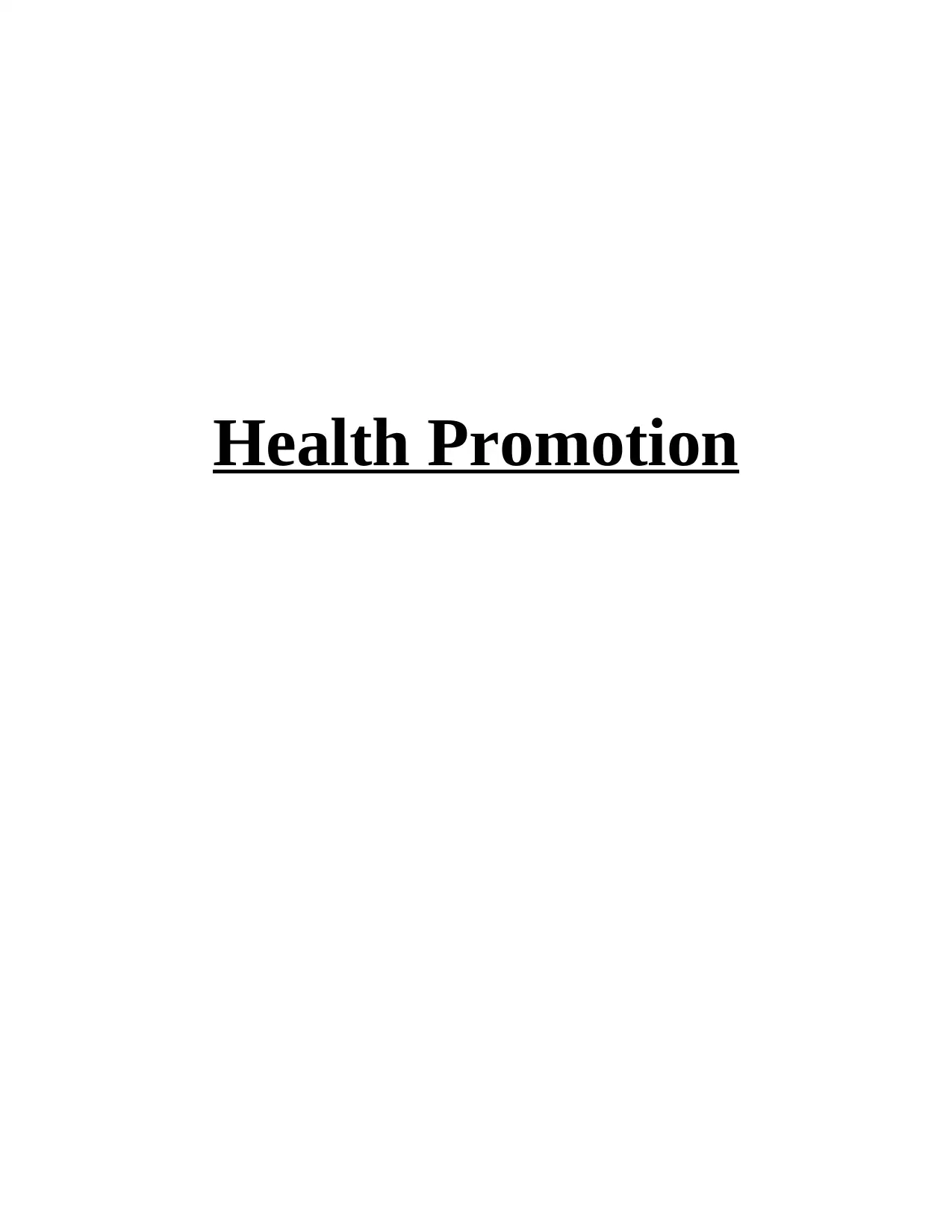
Health Promotion
Paraphrase This Document
Need a fresh take? Get an instant paraphrase of this document with our AI Paraphraser
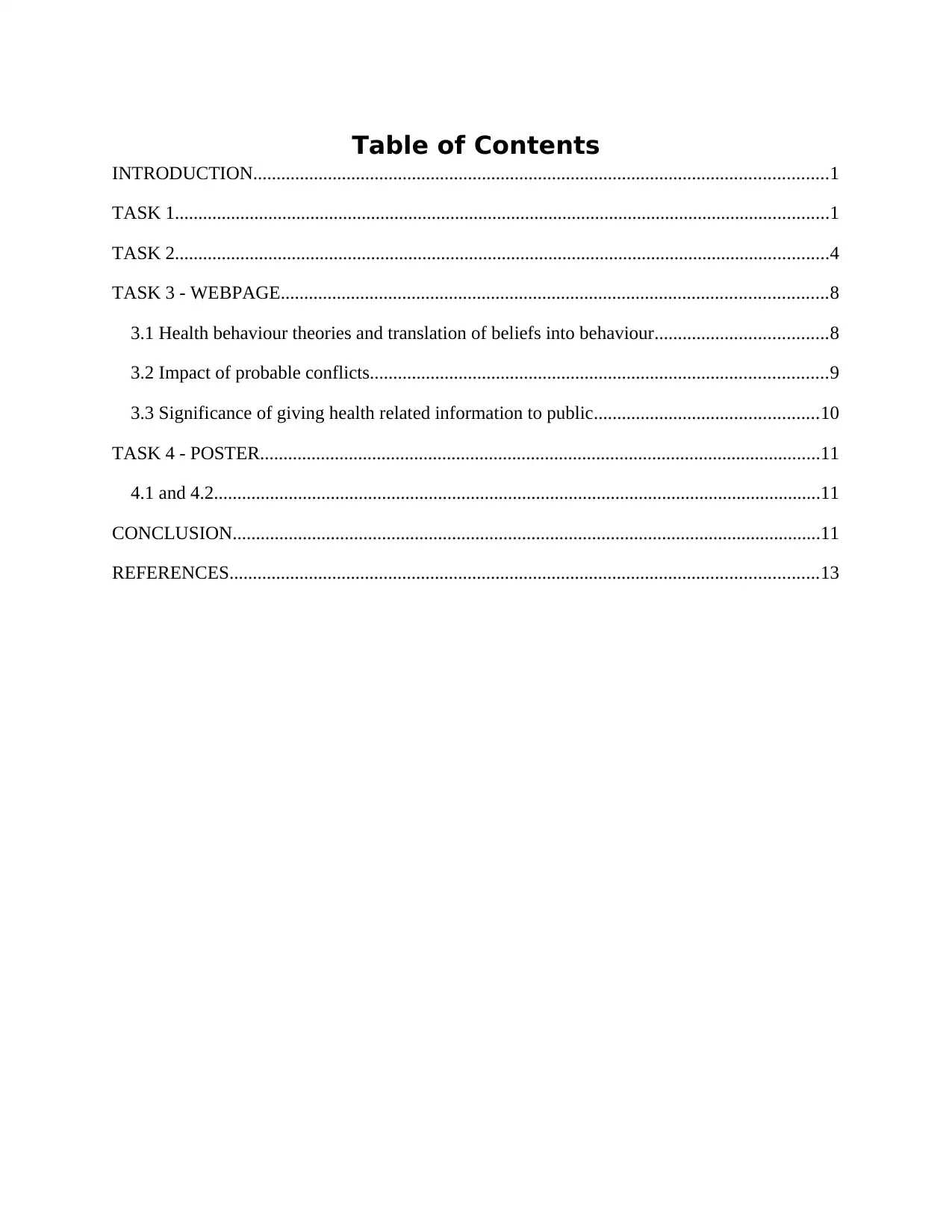
Table of Contents
INTRODUCTION...........................................................................................................................1
TASK 1............................................................................................................................................1
TASK 2............................................................................................................................................4
TASK 3 - WEBPAGE.....................................................................................................................8
3.1 Health behaviour theories and translation of beliefs into behaviour.....................................8
3.2 Impact of probable conflicts..................................................................................................9
3.3 Significance of giving health related information to public................................................10
TASK 4 - POSTER........................................................................................................................11
4.1 and 4.2..................................................................................................................................11
CONCLUSION..............................................................................................................................11
REFERENCES..............................................................................................................................13
INTRODUCTION...........................................................................................................................1
TASK 1............................................................................................................................................1
TASK 2............................................................................................................................................4
TASK 3 - WEBPAGE.....................................................................................................................8
3.1 Health behaviour theories and translation of beliefs into behaviour.....................................8
3.2 Impact of probable conflicts..................................................................................................9
3.3 Significance of giving health related information to public................................................10
TASK 4 - POSTER........................................................................................................................11
4.1 and 4.2..................................................................................................................................11
CONCLUSION..............................................................................................................................11
REFERENCES..............................................................................................................................13
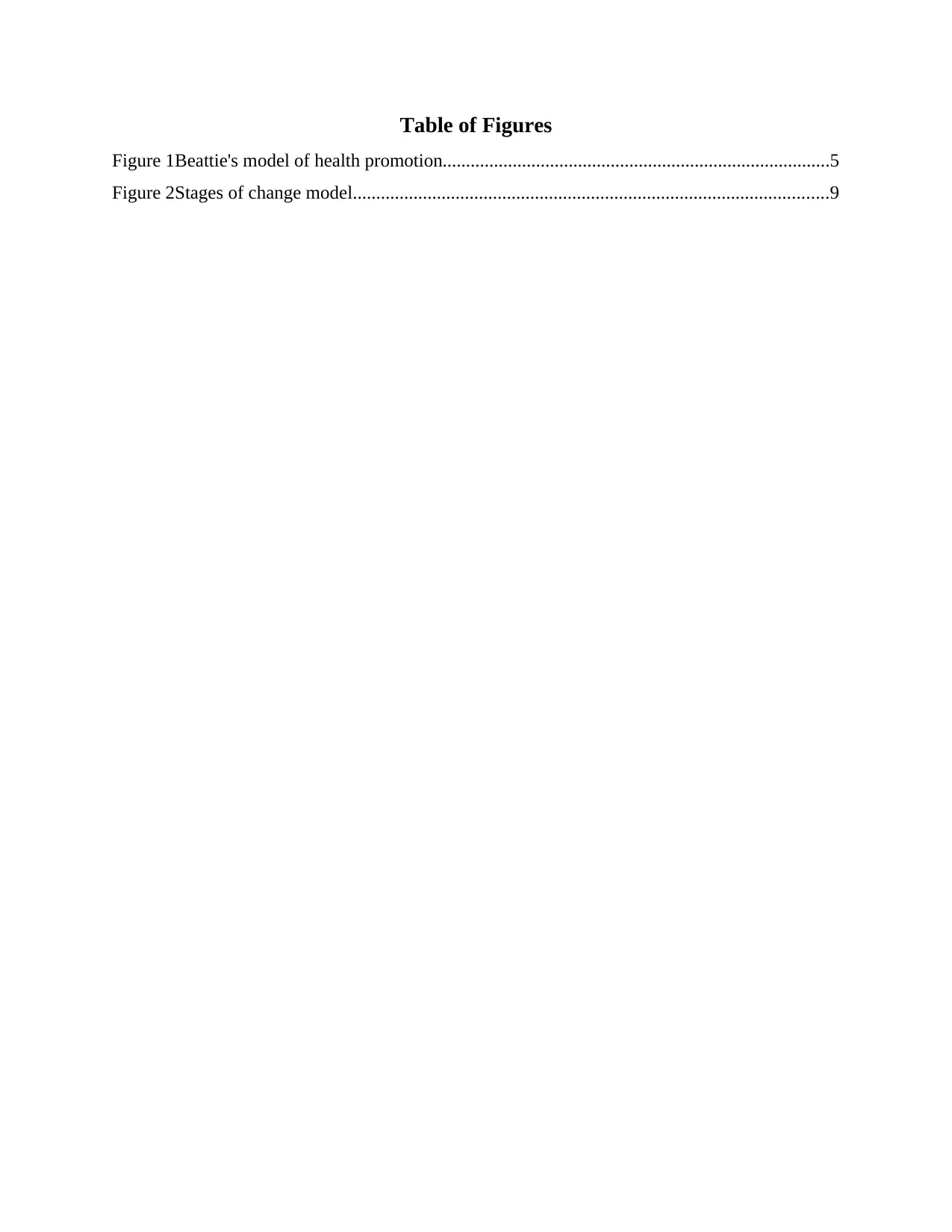
Table of Figures
Figure 1Beattie's model of health promotion...................................................................................5
Figure 2Stages of change model......................................................................................................9
Figure 1Beattie's model of health promotion...................................................................................5
Figure 2Stages of change model......................................................................................................9
⊘ This is a preview!⊘
Do you want full access?
Subscribe today to unlock all pages.

Trusted by 1+ million students worldwide
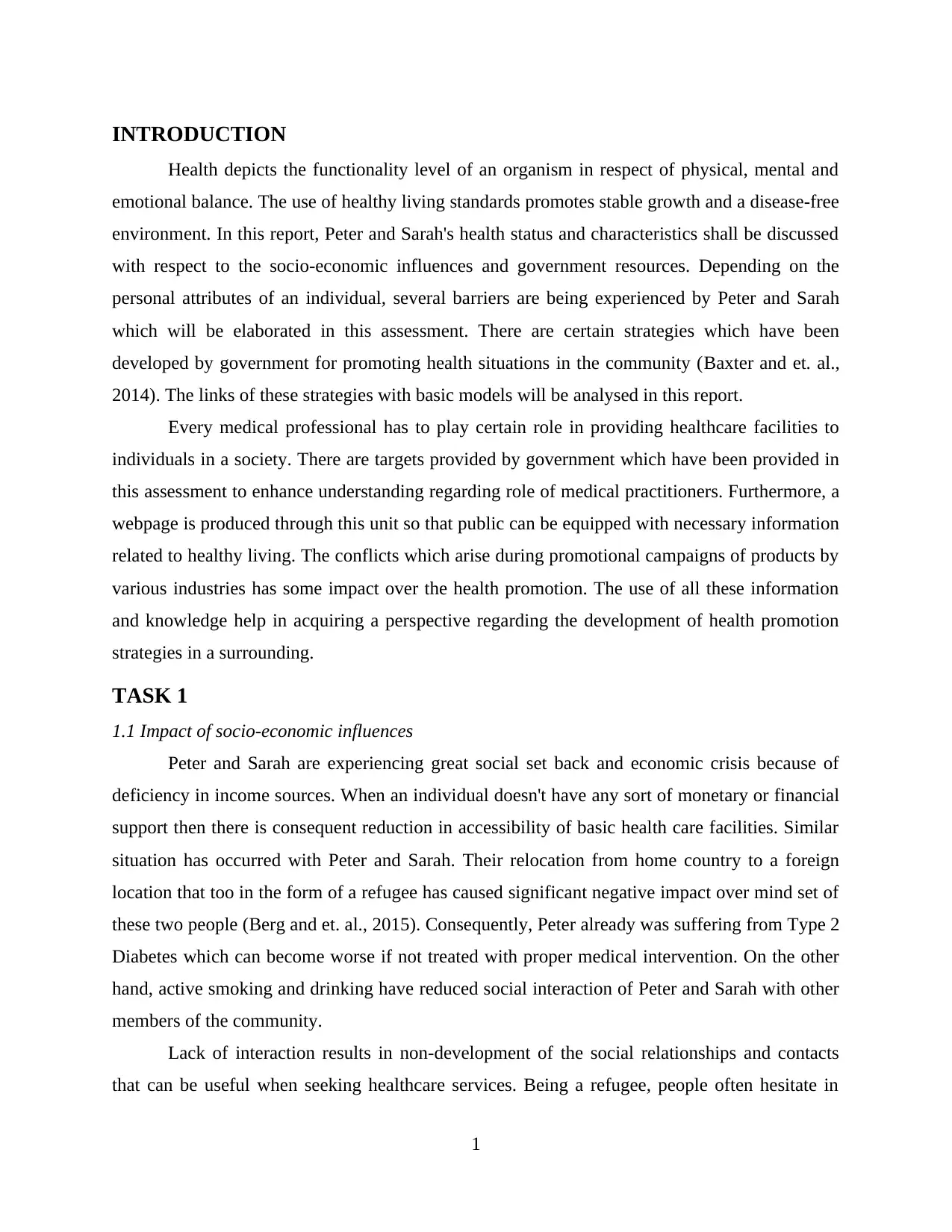
INTRODUCTION
Health depicts the functionality level of an organism in respect of physical, mental and
emotional balance. The use of healthy living standards promotes stable growth and a disease-free
environment. In this report, Peter and Sarah's health status and characteristics shall be discussed
with respect to the socio-economic influences and government resources. Depending on the
personal attributes of an individual, several barriers are being experienced by Peter and Sarah
which will be elaborated in this assessment. There are certain strategies which have been
developed by government for promoting health situations in the community (Baxter and et. al.,
2014). The links of these strategies with basic models will be analysed in this report.
Every medical professional has to play certain role in providing healthcare facilities to
individuals in a society. There are targets provided by government which have been provided in
this assessment to enhance understanding regarding role of medical practitioners. Furthermore, a
webpage is produced through this unit so that public can be equipped with necessary information
related to healthy living. The conflicts which arise during promotional campaigns of products by
various industries has some impact over the health promotion. The use of all these information
and knowledge help in acquiring a perspective regarding the development of health promotion
strategies in a surrounding.
TASK 1
1.1 Impact of socio-economic influences
Peter and Sarah are experiencing great social set back and economic crisis because of
deficiency in income sources. When an individual doesn't have any sort of monetary or financial
support then there is consequent reduction in accessibility of basic health care facilities. Similar
situation has occurred with Peter and Sarah. Their relocation from home country to a foreign
location that too in the form of a refugee has caused significant negative impact over mind set of
these two people (Berg and et. al., 2015). Consequently, Peter already was suffering from Type 2
Diabetes which can become worse if not treated with proper medical intervention. On the other
hand, active smoking and drinking have reduced social interaction of Peter and Sarah with other
members of the community.
Lack of interaction results in non-development of the social relationships and contacts
that can be useful when seeking healthcare services. Being a refugee, people often hesitate in
1
Health depicts the functionality level of an organism in respect of physical, mental and
emotional balance. The use of healthy living standards promotes stable growth and a disease-free
environment. In this report, Peter and Sarah's health status and characteristics shall be discussed
with respect to the socio-economic influences and government resources. Depending on the
personal attributes of an individual, several barriers are being experienced by Peter and Sarah
which will be elaborated in this assessment. There are certain strategies which have been
developed by government for promoting health situations in the community (Baxter and et. al.,
2014). The links of these strategies with basic models will be analysed in this report.
Every medical professional has to play certain role in providing healthcare facilities to
individuals in a society. There are targets provided by government which have been provided in
this assessment to enhance understanding regarding role of medical practitioners. Furthermore, a
webpage is produced through this unit so that public can be equipped with necessary information
related to healthy living. The conflicts which arise during promotional campaigns of products by
various industries has some impact over the health promotion. The use of all these information
and knowledge help in acquiring a perspective regarding the development of health promotion
strategies in a surrounding.
TASK 1
1.1 Impact of socio-economic influences
Peter and Sarah are experiencing great social set back and economic crisis because of
deficiency in income sources. When an individual doesn't have any sort of monetary or financial
support then there is consequent reduction in accessibility of basic health care facilities. Similar
situation has occurred with Peter and Sarah. Their relocation from home country to a foreign
location that too in the form of a refugee has caused significant negative impact over mind set of
these two people (Berg and et. al., 2015). Consequently, Peter already was suffering from Type 2
Diabetes which can become worse if not treated with proper medical intervention. On the other
hand, active smoking and drinking have reduced social interaction of Peter and Sarah with other
members of the community.
Lack of interaction results in non-development of the social relationships and contacts
that can be useful when seeking healthcare services. Being a refugee, people often hesitate in
1
Paraphrase This Document
Need a fresh take? Get an instant paraphrase of this document with our AI Paraphraser
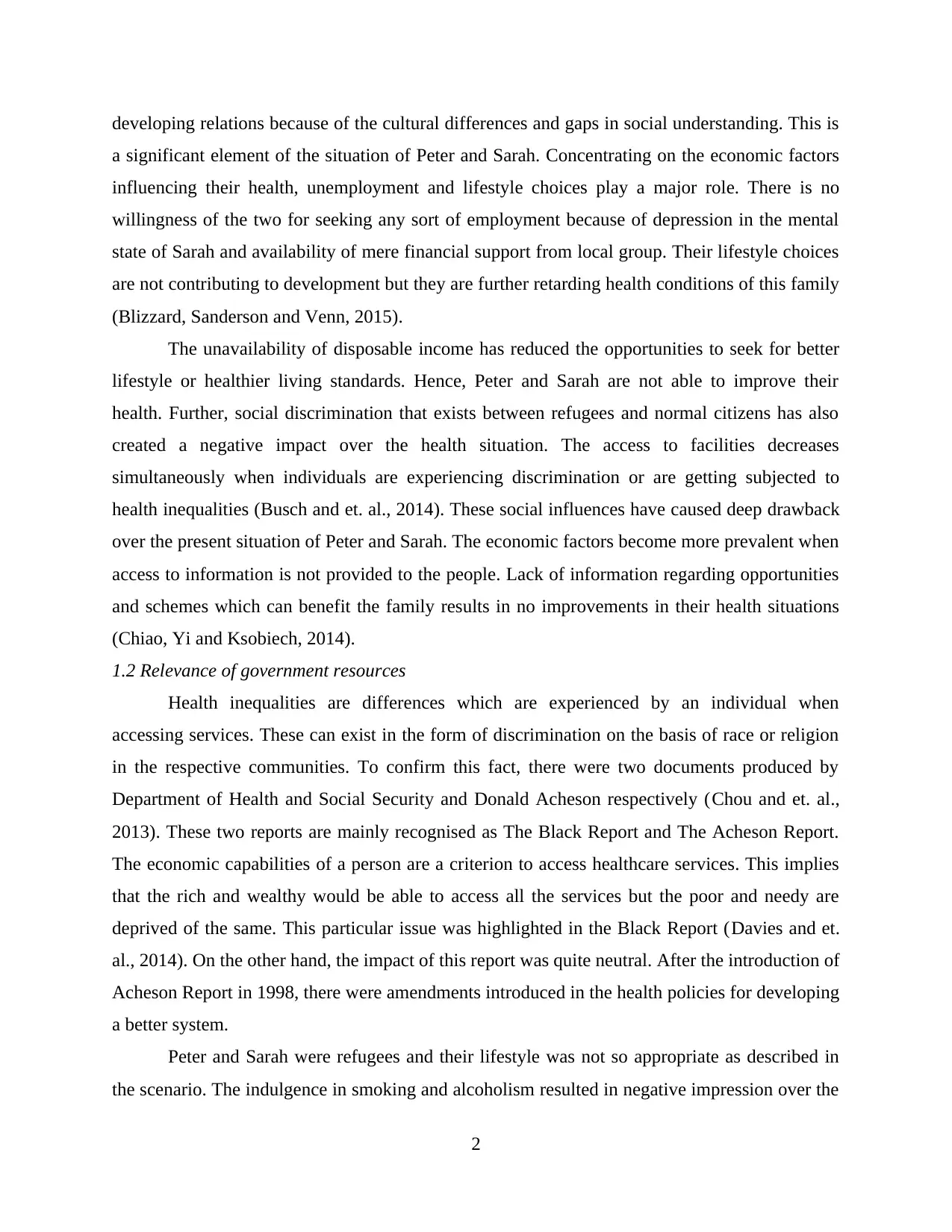
developing relations because of the cultural differences and gaps in social understanding. This is
a significant element of the situation of Peter and Sarah. Concentrating on the economic factors
influencing their health, unemployment and lifestyle choices play a major role. There is no
willingness of the two for seeking any sort of employment because of depression in the mental
state of Sarah and availability of mere financial support from local group. Their lifestyle choices
are not contributing to development but they are further retarding health conditions of this family
(Blizzard, Sanderson and Venn, 2015).
The unavailability of disposable income has reduced the opportunities to seek for better
lifestyle or healthier living standards. Hence, Peter and Sarah are not able to improve their
health. Further, social discrimination that exists between refugees and normal citizens has also
created a negative impact over the health situation. The access to facilities decreases
simultaneously when individuals are experiencing discrimination or are getting subjected to
health inequalities (Busch and et. al., 2014). These social influences have caused deep drawback
over the present situation of Peter and Sarah. The economic factors become more prevalent when
access to information is not provided to the people. Lack of information regarding opportunities
and schemes which can benefit the family results in no improvements in their health situations
(Chiao, Yi and Ksobiech, 2014).
1.2 Relevance of government resources
Health inequalities are differences which are experienced by an individual when
accessing services. These can exist in the form of discrimination on the basis of race or religion
in the respective communities. To confirm this fact, there were two documents produced by
Department of Health and Social Security and Donald Acheson respectively (Chou and et. al.,
2013). These two reports are mainly recognised as The Black Report and The Acheson Report.
The economic capabilities of a person are a criterion to access healthcare services. This implies
that the rich and wealthy would be able to access all the services but the poor and needy are
deprived of the same. This particular issue was highlighted in the Black Report (Davies and et.
al., 2014). On the other hand, the impact of this report was quite neutral. After the introduction of
Acheson Report in 1998, there were amendments introduced in the health policies for developing
a better system.
Peter and Sarah were refugees and their lifestyle was not so appropriate as described in
the scenario. The indulgence in smoking and alcoholism resulted in negative impression over the
2
a significant element of the situation of Peter and Sarah. Concentrating on the economic factors
influencing their health, unemployment and lifestyle choices play a major role. There is no
willingness of the two for seeking any sort of employment because of depression in the mental
state of Sarah and availability of mere financial support from local group. Their lifestyle choices
are not contributing to development but they are further retarding health conditions of this family
(Blizzard, Sanderson and Venn, 2015).
The unavailability of disposable income has reduced the opportunities to seek for better
lifestyle or healthier living standards. Hence, Peter and Sarah are not able to improve their
health. Further, social discrimination that exists between refugees and normal citizens has also
created a negative impact over the health situation. The access to facilities decreases
simultaneously when individuals are experiencing discrimination or are getting subjected to
health inequalities (Busch and et. al., 2014). These social influences have caused deep drawback
over the present situation of Peter and Sarah. The economic factors become more prevalent when
access to information is not provided to the people. Lack of information regarding opportunities
and schemes which can benefit the family results in no improvements in their health situations
(Chiao, Yi and Ksobiech, 2014).
1.2 Relevance of government resources
Health inequalities are differences which are experienced by an individual when
accessing services. These can exist in the form of discrimination on the basis of race or religion
in the respective communities. To confirm this fact, there were two documents produced by
Department of Health and Social Security and Donald Acheson respectively (Chou and et. al.,
2013). These two reports are mainly recognised as The Black Report and The Acheson Report.
The economic capabilities of a person are a criterion to access healthcare services. This implies
that the rich and wealthy would be able to access all the services but the poor and needy are
deprived of the same. This particular issue was highlighted in the Black Report (Davies and et.
al., 2014). On the other hand, the impact of this report was quite neutral. After the introduction of
Acheson Report in 1998, there were amendments introduced in the health policies for developing
a better system.
Peter and Sarah were refugees and their lifestyle was not so appropriate as described in
the scenario. The indulgence in smoking and alcoholism resulted in negative impression over the
2
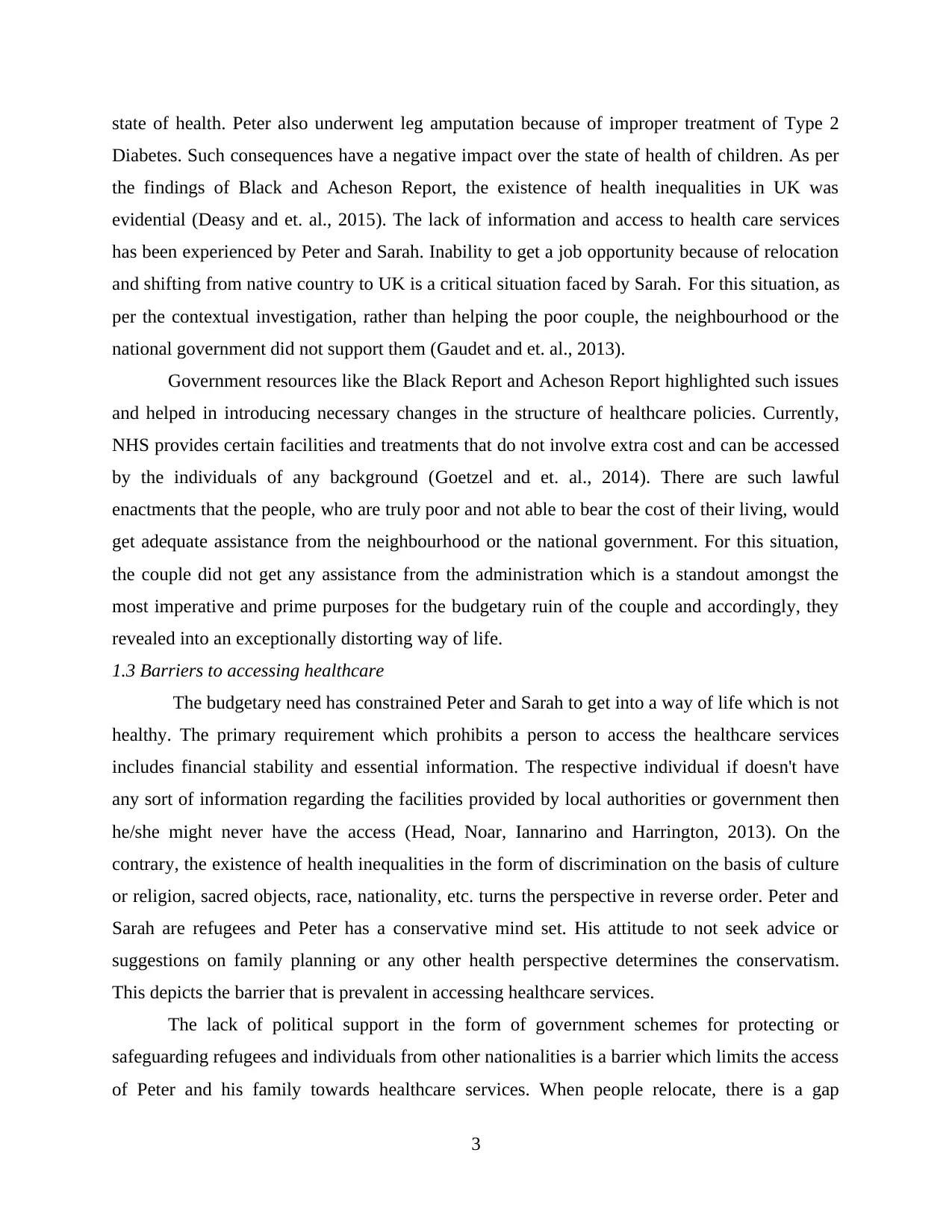
state of health. Peter also underwent leg amputation because of improper treatment of Type 2
Diabetes. Such consequences have a negative impact over the state of health of children. As per
the findings of Black and Acheson Report, the existence of health inequalities in UK was
evidential (Deasy and et. al., 2015). The lack of information and access to health care services
has been experienced by Peter and Sarah. Inability to get a job opportunity because of relocation
and shifting from native country to UK is a critical situation faced by Sarah. For this situation, as
per the contextual investigation, rather than helping the poor couple, the neighbourhood or the
national government did not support them (Gaudet and et. al., 2013).
Government resources like the Black Report and Acheson Report highlighted such issues
and helped in introducing necessary changes in the structure of healthcare policies. Currently,
NHS provides certain facilities and treatments that do not involve extra cost and can be accessed
by the individuals of any background (Goetzel and et. al., 2014). There are such lawful
enactments that the people, who are truly poor and not able to bear the cost of their living, would
get adequate assistance from the neighbourhood or the national government. For this situation,
the couple did not get any assistance from the administration which is a standout amongst the
most imperative and prime purposes for the budgetary ruin of the couple and accordingly, they
revealed into an exceptionally distorting way of life.
1.3 Barriers to accessing healthcare
The budgetary need has constrained Peter and Sarah to get into a way of life which is not
healthy. The primary requirement which prohibits a person to access the healthcare services
includes financial stability and essential information. The respective individual if doesn't have
any sort of information regarding the facilities provided by local authorities or government then
he/she might never have the access (Head, Noar, Iannarino and Harrington, 2013). On the
contrary, the existence of health inequalities in the form of discrimination on the basis of culture
or religion, sacred objects, race, nationality, etc. turns the perspective in reverse order. Peter and
Sarah are refugees and Peter has a conservative mind set. His attitude to not seek advice or
suggestions on family planning or any other health perspective determines the conservatism.
This depicts the barrier that is prevalent in accessing healthcare services.
The lack of political support in the form of government schemes for protecting or
safeguarding refugees and individuals from other nationalities is a barrier which limits the access
of Peter and his family towards healthcare services. When people relocate, there is a gap
3
Diabetes. Such consequences have a negative impact over the state of health of children. As per
the findings of Black and Acheson Report, the existence of health inequalities in UK was
evidential (Deasy and et. al., 2015). The lack of information and access to health care services
has been experienced by Peter and Sarah. Inability to get a job opportunity because of relocation
and shifting from native country to UK is a critical situation faced by Sarah. For this situation, as
per the contextual investigation, rather than helping the poor couple, the neighbourhood or the
national government did not support them (Gaudet and et. al., 2013).
Government resources like the Black Report and Acheson Report highlighted such issues
and helped in introducing necessary changes in the structure of healthcare policies. Currently,
NHS provides certain facilities and treatments that do not involve extra cost and can be accessed
by the individuals of any background (Goetzel and et. al., 2014). There are such lawful
enactments that the people, who are truly poor and not able to bear the cost of their living, would
get adequate assistance from the neighbourhood or the national government. For this situation,
the couple did not get any assistance from the administration which is a standout amongst the
most imperative and prime purposes for the budgetary ruin of the couple and accordingly, they
revealed into an exceptionally distorting way of life.
1.3 Barriers to accessing healthcare
The budgetary need has constrained Peter and Sarah to get into a way of life which is not
healthy. The primary requirement which prohibits a person to access the healthcare services
includes financial stability and essential information. The respective individual if doesn't have
any sort of information regarding the facilities provided by local authorities or government then
he/she might never have the access (Head, Noar, Iannarino and Harrington, 2013). On the
contrary, the existence of health inequalities in the form of discrimination on the basis of culture
or religion, sacred objects, race, nationality, etc. turns the perspective in reverse order. Peter and
Sarah are refugees and Peter has a conservative mind set. His attitude to not seek advice or
suggestions on family planning or any other health perspective determines the conservatism.
This depicts the barrier that is prevalent in accessing healthcare services.
The lack of political support in the form of government schemes for protecting or
safeguarding refugees and individuals from other nationalities is a barrier which limits the access
of Peter and his family towards healthcare services. When people relocate, there is a gap
3
⊘ This is a preview!⊘
Do you want full access?
Subscribe today to unlock all pages.

Trusted by 1+ million students worldwide
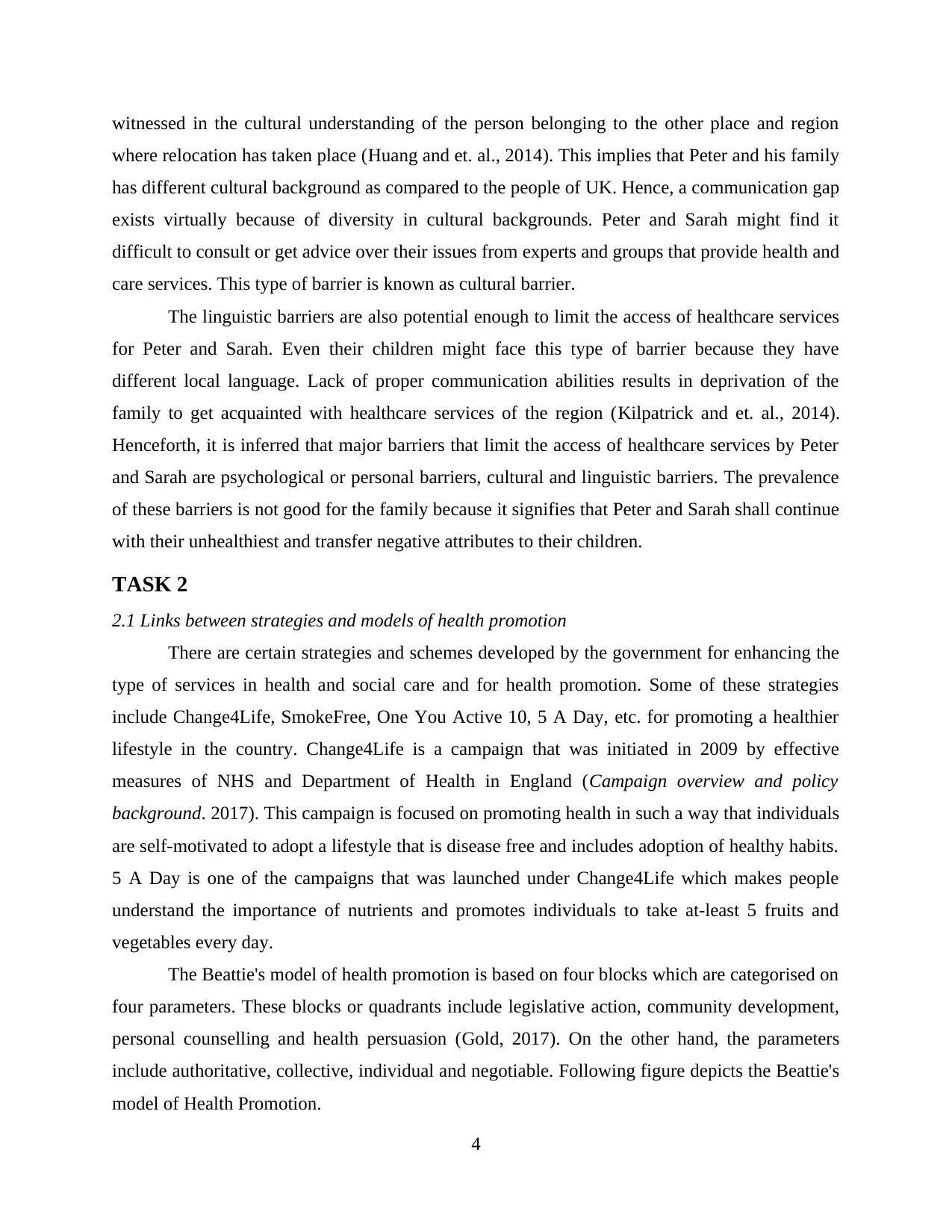
witnessed in the cultural understanding of the person belonging to the other place and region
where relocation has taken place (Huang and et. al., 2014). This implies that Peter and his family
has different cultural background as compared to the people of UK. Hence, a communication gap
exists virtually because of diversity in cultural backgrounds. Peter and Sarah might find it
difficult to consult or get advice over their issues from experts and groups that provide health and
care services. This type of barrier is known as cultural barrier.
The linguistic barriers are also potential enough to limit the access of healthcare services
for Peter and Sarah. Even their children might face this type of barrier because they have
different local language. Lack of proper communication abilities results in deprivation of the
family to get acquainted with healthcare services of the region (Kilpatrick and et. al., 2014).
Henceforth, it is inferred that major barriers that limit the access of healthcare services by Peter
and Sarah are psychological or personal barriers, cultural and linguistic barriers. The prevalence
of these barriers is not good for the family because it signifies that Peter and Sarah shall continue
with their unhealthiest and transfer negative attributes to their children.
TASK 2
2.1 Links between strategies and models of health promotion
There are certain strategies and schemes developed by the government for enhancing the
type of services in health and social care and for health promotion. Some of these strategies
include Change4Life, SmokeFree, One You Active 10, 5 A Day, etc. for promoting a healthier
lifestyle in the country. Change4Life is a campaign that was initiated in 2009 by effective
measures of NHS and Department of Health in England (Campaign overview and policy
background. 2017). This campaign is focused on promoting health in such a way that individuals
are self-motivated to adopt a lifestyle that is disease free and includes adoption of healthy habits.
5 A Day is one of the campaigns that was launched under Change4Life which makes people
understand the importance of nutrients and promotes individuals to take at-least 5 fruits and
vegetables every day.
The Beattie's model of health promotion is based on four blocks which are categorised on
four parameters. These blocks or quadrants include legislative action, community development,
personal counselling and health persuasion (Gold, 2017). On the other hand, the parameters
include authoritative, collective, individual and negotiable. Following figure depicts the Beattie's
model of Health Promotion.
4
where relocation has taken place (Huang and et. al., 2014). This implies that Peter and his family
has different cultural background as compared to the people of UK. Hence, a communication gap
exists virtually because of diversity in cultural backgrounds. Peter and Sarah might find it
difficult to consult or get advice over their issues from experts and groups that provide health and
care services. This type of barrier is known as cultural barrier.
The linguistic barriers are also potential enough to limit the access of healthcare services
for Peter and Sarah. Even their children might face this type of barrier because they have
different local language. Lack of proper communication abilities results in deprivation of the
family to get acquainted with healthcare services of the region (Kilpatrick and et. al., 2014).
Henceforth, it is inferred that major barriers that limit the access of healthcare services by Peter
and Sarah are psychological or personal barriers, cultural and linguistic barriers. The prevalence
of these barriers is not good for the family because it signifies that Peter and Sarah shall continue
with their unhealthiest and transfer negative attributes to their children.
TASK 2
2.1 Links between strategies and models of health promotion
There are certain strategies and schemes developed by the government for enhancing the
type of services in health and social care and for health promotion. Some of these strategies
include Change4Life, SmokeFree, One You Active 10, 5 A Day, etc. for promoting a healthier
lifestyle in the country. Change4Life is a campaign that was initiated in 2009 by effective
measures of NHS and Department of Health in England (Campaign overview and policy
background. 2017). This campaign is focused on promoting health in such a way that individuals
are self-motivated to adopt a lifestyle that is disease free and includes adoption of healthy habits.
5 A Day is one of the campaigns that was launched under Change4Life which makes people
understand the importance of nutrients and promotes individuals to take at-least 5 fruits and
vegetables every day.
The Beattie's model of health promotion is based on four blocks which are categorised on
four parameters. These blocks or quadrants include legislative action, community development,
personal counselling and health persuasion (Gold, 2017). On the other hand, the parameters
include authoritative, collective, individual and negotiable. Following figure depicts the Beattie's
model of Health Promotion.
4
Paraphrase This Document
Need a fresh take? Get an instant paraphrase of this document with our AI Paraphraser
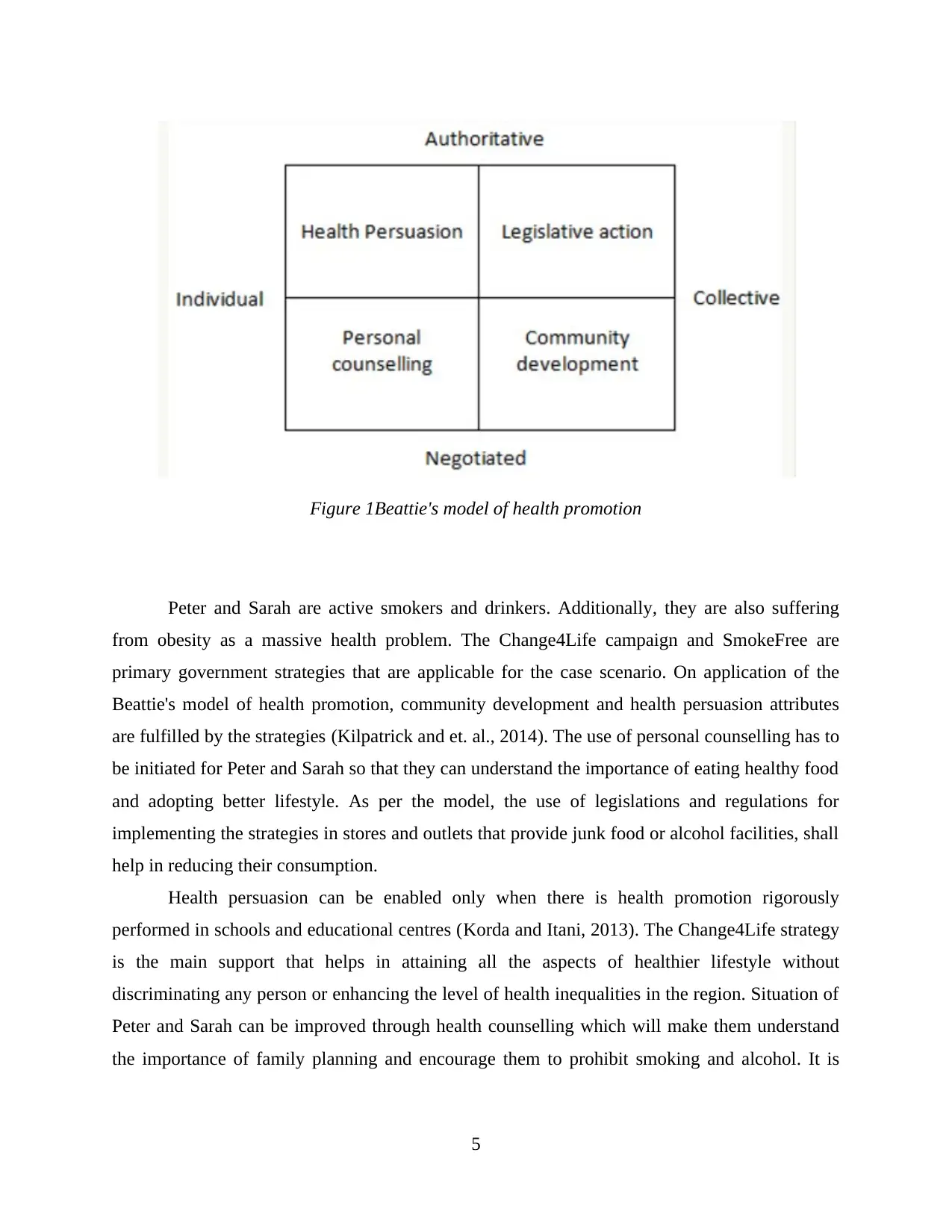
Peter and Sarah are active smokers and drinkers. Additionally, they are also suffering
from obesity as a massive health problem. The Change4Life campaign and SmokeFree are
primary government strategies that are applicable for the case scenario. On application of the
Beattie's model of health promotion, community development and health persuasion attributes
are fulfilled by the strategies (Kilpatrick and et. al., 2014). The use of personal counselling has to
be initiated for Peter and Sarah so that they can understand the importance of eating healthy food
and adopting better lifestyle. As per the model, the use of legislations and regulations for
implementing the strategies in stores and outlets that provide junk food or alcohol facilities, shall
help in reducing their consumption.
Health persuasion can be enabled only when there is health promotion rigorously
performed in schools and educational centres (Korda and Itani, 2013). The Change4Life strategy
is the main support that helps in attaining all the aspects of healthier lifestyle without
discriminating any person or enhancing the level of health inequalities in the region. Situation of
Peter and Sarah can be improved through health counselling which will make them understand
the importance of family planning and encourage them to prohibit smoking and alcohol. It is
5
Figure 1Beattie's model of health promotion
from obesity as a massive health problem. The Change4Life campaign and SmokeFree are
primary government strategies that are applicable for the case scenario. On application of the
Beattie's model of health promotion, community development and health persuasion attributes
are fulfilled by the strategies (Kilpatrick and et. al., 2014). The use of personal counselling has to
be initiated for Peter and Sarah so that they can understand the importance of eating healthy food
and adopting better lifestyle. As per the model, the use of legislations and regulations for
implementing the strategies in stores and outlets that provide junk food or alcohol facilities, shall
help in reducing their consumption.
Health persuasion can be enabled only when there is health promotion rigorously
performed in schools and educational centres (Korda and Itani, 2013). The Change4Life strategy
is the main support that helps in attaining all the aspects of healthier lifestyle without
discriminating any person or enhancing the level of health inequalities in the region. Situation of
Peter and Sarah can be improved through health counselling which will make them understand
the importance of family planning and encourage them to prohibit smoking and alcohol. It is
5
Figure 1Beattie's model of health promotion
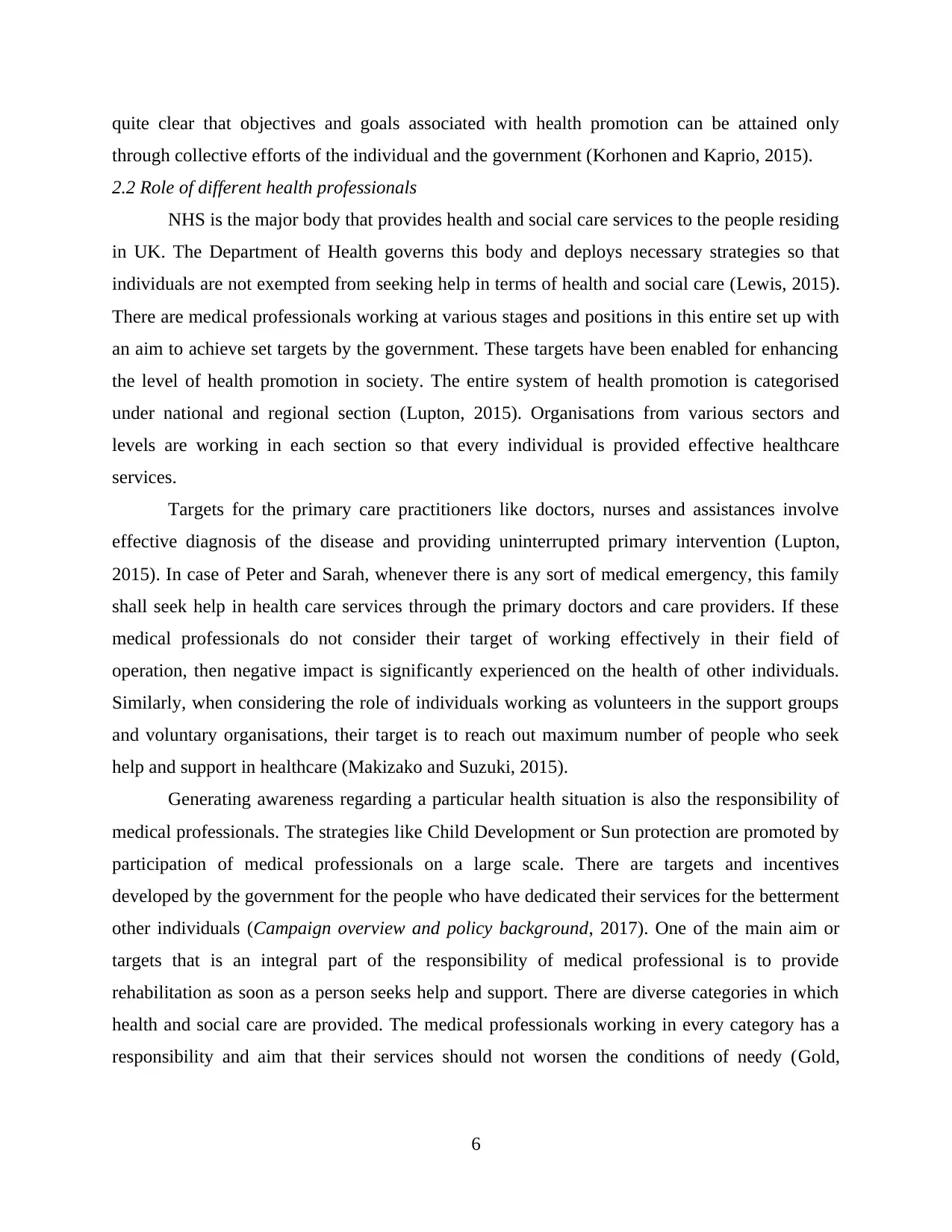
quite clear that objectives and goals associated with health promotion can be attained only
through collective efforts of the individual and the government (Korhonen and Kaprio, 2015).
2.2 Role of different health professionals
NHS is the major body that provides health and social care services to the people residing
in UK. The Department of Health governs this body and deploys necessary strategies so that
individuals are not exempted from seeking help in terms of health and social care (Lewis, 2015).
There are medical professionals working at various stages and positions in this entire set up with
an aim to achieve set targets by the government. These targets have been enabled for enhancing
the level of health promotion in society. The entire system of health promotion is categorised
under national and regional section (Lupton, 2015). Organisations from various sectors and
levels are working in each section so that every individual is provided effective healthcare
services.
Targets for the primary care practitioners like doctors, nurses and assistances involve
effective diagnosis of the disease and providing uninterrupted primary intervention (Lupton,
2015). In case of Peter and Sarah, whenever there is any sort of medical emergency, this family
shall seek help in health care services through the primary doctors and care providers. If these
medical professionals do not consider their target of working effectively in their field of
operation, then negative impact is significantly experienced on the health of other individuals.
Similarly, when considering the role of individuals working as volunteers in the support groups
and voluntary organisations, their target is to reach out maximum number of people who seek
help and support in healthcare (Makizako and Suzuki, 2015).
Generating awareness regarding a particular health situation is also the responsibility of
medical professionals. The strategies like Child Development or Sun protection are promoted by
participation of medical professionals on a large scale. There are targets and incentives
developed by the government for the people who have dedicated their services for the betterment
other individuals (Campaign overview and policy background, 2017). One of the main aim or
targets that is an integral part of the responsibility of medical professional is to provide
rehabilitation as soon as a person seeks help and support. There are diverse categories in which
health and social care are provided. The medical professionals working in every category has a
responsibility and aim that their services should not worsen the conditions of needy (Gold,
6
through collective efforts of the individual and the government (Korhonen and Kaprio, 2015).
2.2 Role of different health professionals
NHS is the major body that provides health and social care services to the people residing
in UK. The Department of Health governs this body and deploys necessary strategies so that
individuals are not exempted from seeking help in terms of health and social care (Lewis, 2015).
There are medical professionals working at various stages and positions in this entire set up with
an aim to achieve set targets by the government. These targets have been enabled for enhancing
the level of health promotion in society. The entire system of health promotion is categorised
under national and regional section (Lupton, 2015). Organisations from various sectors and
levels are working in each section so that every individual is provided effective healthcare
services.
Targets for the primary care practitioners like doctors, nurses and assistances involve
effective diagnosis of the disease and providing uninterrupted primary intervention (Lupton,
2015). In case of Peter and Sarah, whenever there is any sort of medical emergency, this family
shall seek help in health care services through the primary doctors and care providers. If these
medical professionals do not consider their target of working effectively in their field of
operation, then negative impact is significantly experienced on the health of other individuals.
Similarly, when considering the role of individuals working as volunteers in the support groups
and voluntary organisations, their target is to reach out maximum number of people who seek
help and support in healthcare (Makizako and Suzuki, 2015).
Generating awareness regarding a particular health situation is also the responsibility of
medical professionals. The strategies like Child Development or Sun protection are promoted by
participation of medical professionals on a large scale. There are targets and incentives
developed by the government for the people who have dedicated their services for the betterment
other individuals (Campaign overview and policy background, 2017). One of the main aim or
targets that is an integral part of the responsibility of medical professional is to provide
rehabilitation as soon as a person seeks help and support. There are diverse categories in which
health and social care are provided. The medical professionals working in every category has a
responsibility and aim that their services should not worsen the conditions of needy (Gold,
6
⊘ This is a preview!⊘
Do you want full access?
Subscribe today to unlock all pages.

Trusted by 1+ million students worldwide
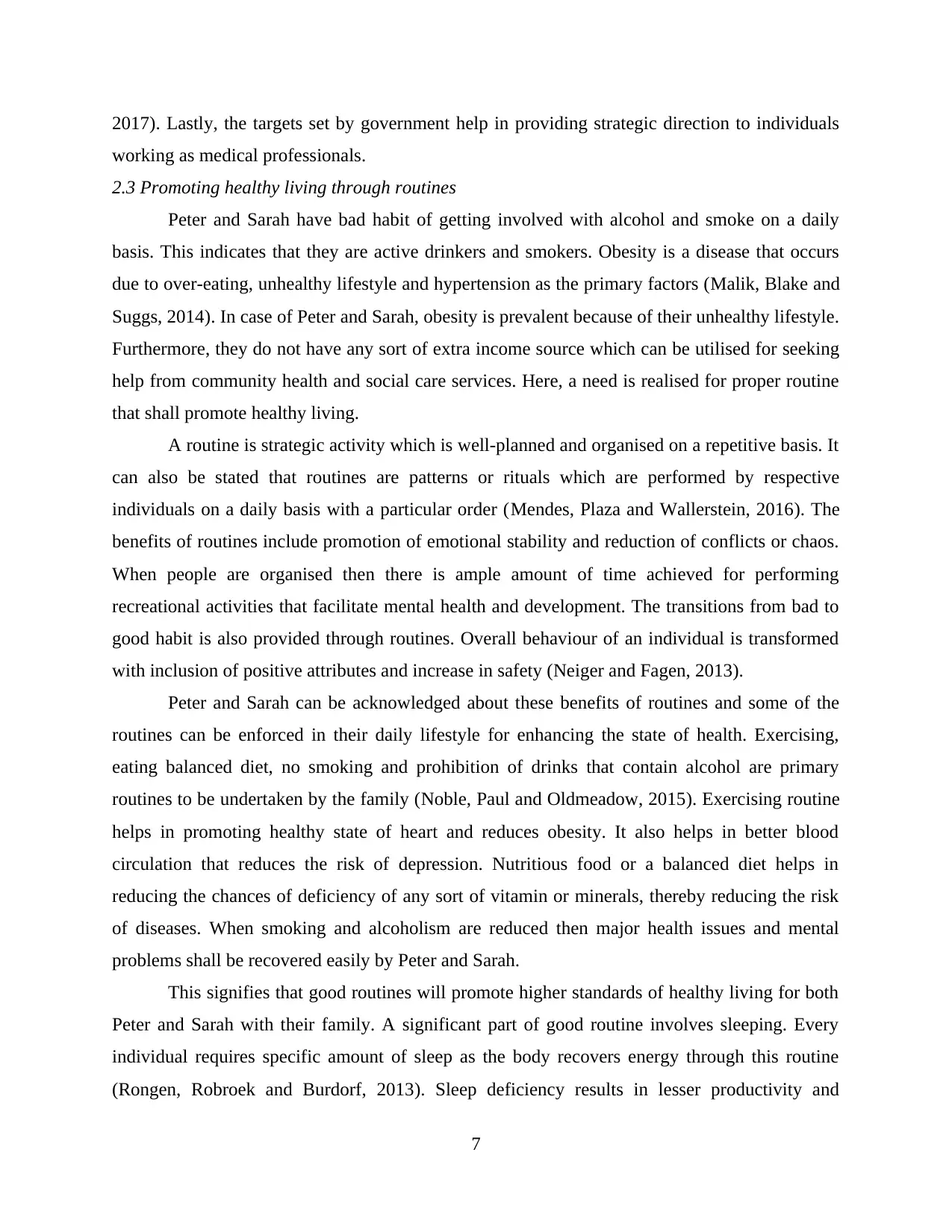
2017). Lastly, the targets set by government help in providing strategic direction to individuals
working as medical professionals.
2.3 Promoting healthy living through routines
Peter and Sarah have bad habit of getting involved with alcohol and smoke on a daily
basis. This indicates that they are active drinkers and smokers. Obesity is a disease that occurs
due to over-eating, unhealthy lifestyle and hypertension as the primary factors (Malik, Blake and
Suggs, 2014). In case of Peter and Sarah, obesity is prevalent because of their unhealthy lifestyle.
Furthermore, they do not have any sort of extra income source which can be utilised for seeking
help from community health and social care services. Here, a need is realised for proper routine
that shall promote healthy living.
A routine is strategic activity which is well-planned and organised on a repetitive basis. It
can also be stated that routines are patterns or rituals which are performed by respective
individuals on a daily basis with a particular order (Mendes, Plaza and Wallerstein, 2016). The
benefits of routines include promotion of emotional stability and reduction of conflicts or chaos.
When people are organised then there is ample amount of time achieved for performing
recreational activities that facilitate mental health and development. The transitions from bad to
good habit is also provided through routines. Overall behaviour of an individual is transformed
with inclusion of positive attributes and increase in safety (Neiger and Fagen, 2013).
Peter and Sarah can be acknowledged about these benefits of routines and some of the
routines can be enforced in their daily lifestyle for enhancing the state of health. Exercising,
eating balanced diet, no smoking and prohibition of drinks that contain alcohol are primary
routines to be undertaken by the family (Noble, Paul and Oldmeadow, 2015). Exercising routine
helps in promoting healthy state of heart and reduces obesity. It also helps in better blood
circulation that reduces the risk of depression. Nutritious food or a balanced diet helps in
reducing the chances of deficiency of any sort of vitamin or minerals, thereby reducing the risk
of diseases. When smoking and alcoholism are reduced then major health issues and mental
problems shall be recovered easily by Peter and Sarah.
This signifies that good routines will promote higher standards of healthy living for both
Peter and Sarah with their family. A significant part of good routine involves sleeping. Every
individual requires specific amount of sleep as the body recovers energy through this routine
(Rongen, Robroek and Burdorf, 2013). Sleep deficiency results in lesser productivity and
7
working as medical professionals.
2.3 Promoting healthy living through routines
Peter and Sarah have bad habit of getting involved with alcohol and smoke on a daily
basis. This indicates that they are active drinkers and smokers. Obesity is a disease that occurs
due to over-eating, unhealthy lifestyle and hypertension as the primary factors (Malik, Blake and
Suggs, 2014). In case of Peter and Sarah, obesity is prevalent because of their unhealthy lifestyle.
Furthermore, they do not have any sort of extra income source which can be utilised for seeking
help from community health and social care services. Here, a need is realised for proper routine
that shall promote healthy living.
A routine is strategic activity which is well-planned and organised on a repetitive basis. It
can also be stated that routines are patterns or rituals which are performed by respective
individuals on a daily basis with a particular order (Mendes, Plaza and Wallerstein, 2016). The
benefits of routines include promotion of emotional stability and reduction of conflicts or chaos.
When people are organised then there is ample amount of time achieved for performing
recreational activities that facilitate mental health and development. The transitions from bad to
good habit is also provided through routines. Overall behaviour of an individual is transformed
with inclusion of positive attributes and increase in safety (Neiger and Fagen, 2013).
Peter and Sarah can be acknowledged about these benefits of routines and some of the
routines can be enforced in their daily lifestyle for enhancing the state of health. Exercising,
eating balanced diet, no smoking and prohibition of drinks that contain alcohol are primary
routines to be undertaken by the family (Noble, Paul and Oldmeadow, 2015). Exercising routine
helps in promoting healthy state of heart and reduces obesity. It also helps in better blood
circulation that reduces the risk of depression. Nutritious food or a balanced diet helps in
reducing the chances of deficiency of any sort of vitamin or minerals, thereby reducing the risk
of diseases. When smoking and alcoholism are reduced then major health issues and mental
problems shall be recovered easily by Peter and Sarah.
This signifies that good routines will promote higher standards of healthy living for both
Peter and Sarah with their family. A significant part of good routine involves sleeping. Every
individual requires specific amount of sleep as the body recovers energy through this routine
(Rongen, Robroek and Burdorf, 2013). Sleep deficiency results in lesser productivity and
7
Paraphrase This Document
Need a fresh take? Get an instant paraphrase of this document with our AI Paraphraser
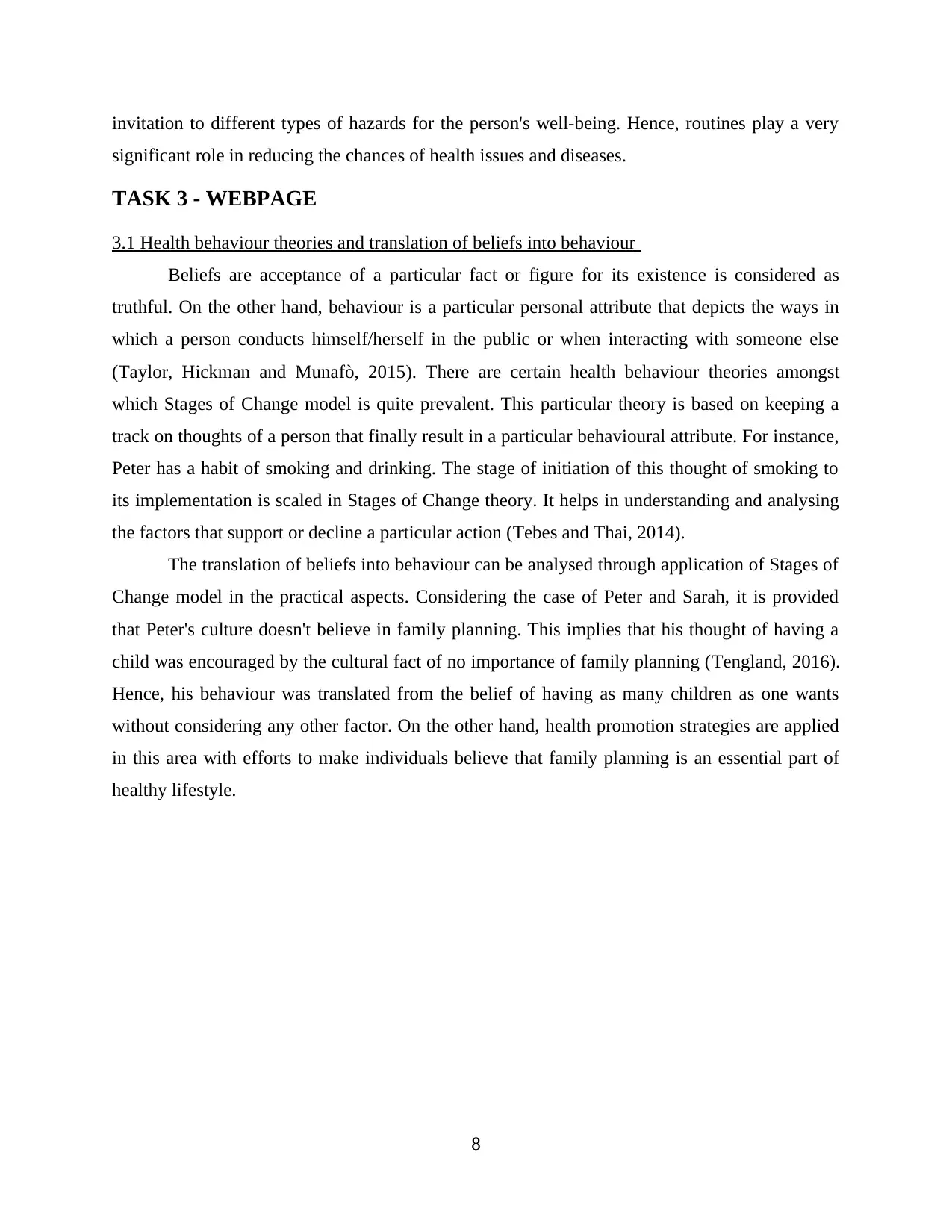
invitation to different types of hazards for the person's well-being. Hence, routines play a very
significant role in reducing the chances of health issues and diseases.
TASK 3 - WEBPAGE
3.1 Health behaviour theories and translation of beliefs into behaviour
Beliefs are acceptance of a particular fact or figure for its existence is considered as
truthful. On the other hand, behaviour is a particular personal attribute that depicts the ways in
which a person conducts himself/herself in the public or when interacting with someone else
(Taylor, Hickman and Munafò, 2015). There are certain health behaviour theories amongst
which Stages of Change model is quite prevalent. This particular theory is based on keeping a
track on thoughts of a person that finally result in a particular behavioural attribute. For instance,
Peter has a habit of smoking and drinking. The stage of initiation of this thought of smoking to
its implementation is scaled in Stages of Change theory. It helps in understanding and analysing
the factors that support or decline a particular action (Tebes and Thai, 2014).
The translation of beliefs into behaviour can be analysed through application of Stages of
Change model in the practical aspects. Considering the case of Peter and Sarah, it is provided
that Peter's culture doesn't believe in family planning. This implies that his thought of having a
child was encouraged by the cultural fact of no importance of family planning (Tengland, 2016).
Hence, his behaviour was translated from the belief of having as many children as one wants
without considering any other factor. On the other hand, health promotion strategies are applied
in this area with efforts to make individuals believe that family planning is an essential part of
healthy lifestyle.
8
significant role in reducing the chances of health issues and diseases.
TASK 3 - WEBPAGE
3.1 Health behaviour theories and translation of beliefs into behaviour
Beliefs are acceptance of a particular fact or figure for its existence is considered as
truthful. On the other hand, behaviour is a particular personal attribute that depicts the ways in
which a person conducts himself/herself in the public or when interacting with someone else
(Taylor, Hickman and Munafò, 2015). There are certain health behaviour theories amongst
which Stages of Change model is quite prevalent. This particular theory is based on keeping a
track on thoughts of a person that finally result in a particular behavioural attribute. For instance,
Peter has a habit of smoking and drinking. The stage of initiation of this thought of smoking to
its implementation is scaled in Stages of Change theory. It helps in understanding and analysing
the factors that support or decline a particular action (Tebes and Thai, 2014).
The translation of beliefs into behaviour can be analysed through application of Stages of
Change model in the practical aspects. Considering the case of Peter and Sarah, it is provided
that Peter's culture doesn't believe in family planning. This implies that his thought of having a
child was encouraged by the cultural fact of no importance of family planning (Tengland, 2016).
Hence, his behaviour was translated from the belief of having as many children as one wants
without considering any other factor. On the other hand, health promotion strategies are applied
in this area with efforts to make individuals believe that family planning is an essential part of
healthy lifestyle.
8
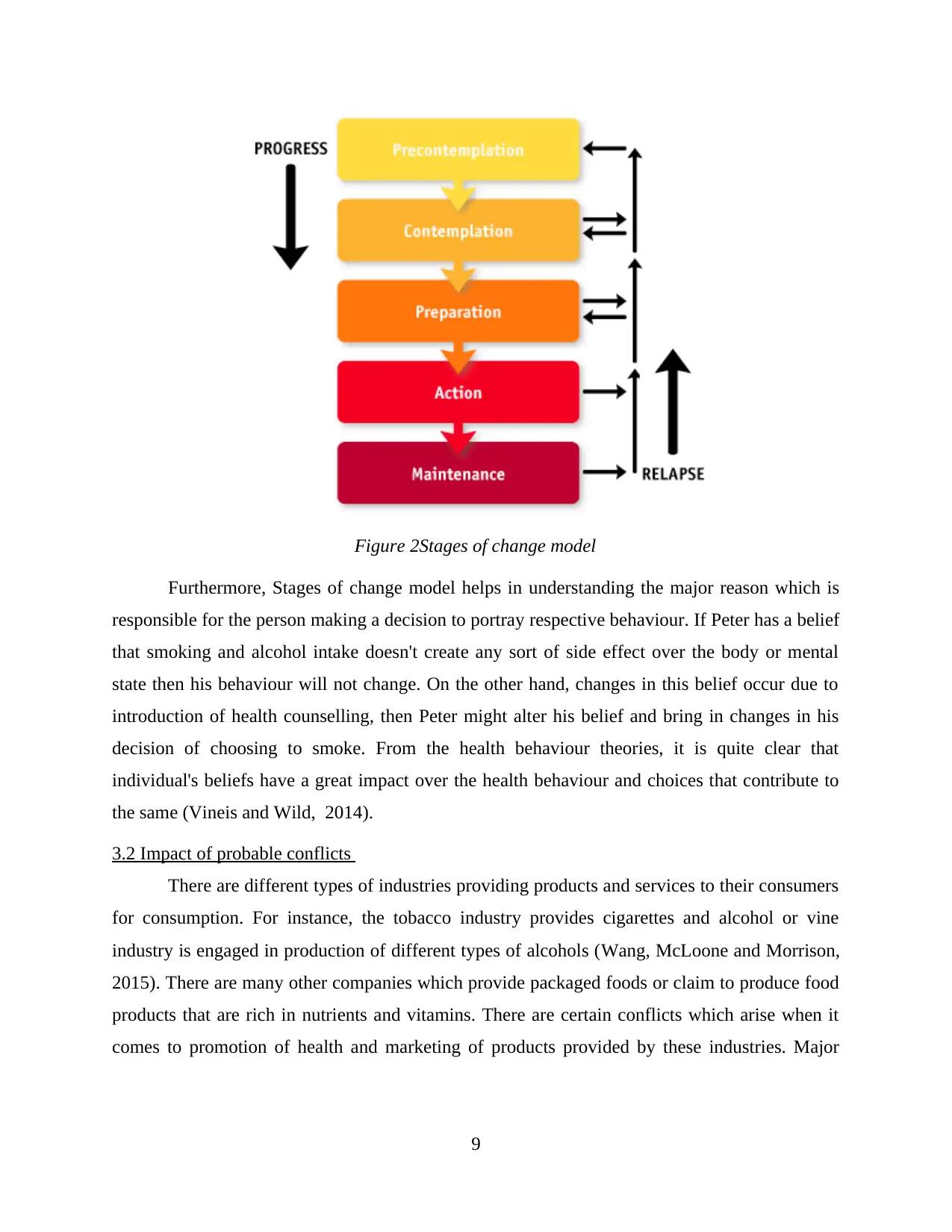
Figure 2Stages of change model
Furthermore, Stages of change model helps in understanding the major reason which is
responsible for the person making a decision to portray respective behaviour. If Peter has a belief
that smoking and alcohol intake doesn't create any sort of side effect over the body or mental
state then his behaviour will not change. On the other hand, changes in this belief occur due to
introduction of health counselling, then Peter might alter his belief and bring in changes in his
decision of choosing to smoke. From the health behaviour theories, it is quite clear that
individual's beliefs have a great impact over the health behaviour and choices that contribute to
the same (Vineis and Wild, 2014).
3.2 Impact of probable conflicts
There are different types of industries providing products and services to their consumers
for consumption. For instance, the tobacco industry provides cigarettes and alcohol or vine
industry is engaged in production of different types of alcohols (Wang, McLoone and Morrison,
2015). There are many other companies which provide packaged foods or claim to produce food
products that are rich in nutrients and vitamins. There are certain conflicts which arise when it
comes to promotion of health and marketing of products provided by these industries. Major
9
Furthermore, Stages of change model helps in understanding the major reason which is
responsible for the person making a decision to portray respective behaviour. If Peter has a belief
that smoking and alcohol intake doesn't create any sort of side effect over the body or mental
state then his behaviour will not change. On the other hand, changes in this belief occur due to
introduction of health counselling, then Peter might alter his belief and bring in changes in his
decision of choosing to smoke. From the health behaviour theories, it is quite clear that
individual's beliefs have a great impact over the health behaviour and choices that contribute to
the same (Vineis and Wild, 2014).
3.2 Impact of probable conflicts
There are different types of industries providing products and services to their consumers
for consumption. For instance, the tobacco industry provides cigarettes and alcohol or vine
industry is engaged in production of different types of alcohols (Wang, McLoone and Morrison,
2015). There are many other companies which provide packaged foods or claim to produce food
products that are rich in nutrients and vitamins. There are certain conflicts which arise when it
comes to promotion of health and marketing of products provided by these industries. Major
9
⊘ This is a preview!⊘
Do you want full access?
Subscribe today to unlock all pages.

Trusted by 1+ million students worldwide
1 out of 18
Related Documents
Your All-in-One AI-Powered Toolkit for Academic Success.
+13062052269
info@desklib.com
Available 24*7 on WhatsApp / Email
![[object Object]](/_next/static/media/star-bottom.7253800d.svg)
Unlock your academic potential
Copyright © 2020–2025 A2Z Services. All Rights Reserved. Developed and managed by ZUCOL.





